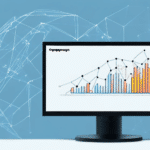Introduction to Business Analytics
Analytics has emerged as a powerful tool for businesses across the world. The ability to analyze data and extract meaningful insights has enabled companies to uncover opportunities for growth, improve decision-making, and optimize performance. In this article, we will explore how analytics can transform your business, from the basics of analytics for business to navigating the landscape of analytics tools and platforms. We will also discuss the most common mistakes businesses make when implementing analytics and provide guidance on how to create a successful analytics strategy for your organization. Finally, we will examine the ethical considerations of data collection and analysis and how to build a data-driven culture within your company.
The Role and Benefits of Analytics in Business
The Role of Analytics in Business Transformation
Analytics is transforming the way businesses operate, making them more data-driven. The use of analytics empowers organizations to adopt a proactive approach to problem-solving, instead of a reactive one. By analyzing data, companies can identify patterns, trends, and outliers that help them uncover opportunities and challenges. The insights generated from analytics also enable businesses to make more informed decisions, drive innovation, improve operational efficiency, and increase profitability.
One of the key benefits of analytics is its ability to help businesses personalize their offerings to customers. By analyzing customer data, businesses can gain insights into their preferences, behaviors, and needs. This information can then be used to tailor products and services to meet specific needs, resulting in increased customer satisfaction and loyalty.
Another important aspect of analytics is its role in risk management. By analyzing data related to potential risks, businesses can identify and mitigate potential threats before they become major issues. This proactive approach can help businesses avoid costly mistakes and ensure that they are better prepared to handle unexpected challenges. According to a SAS report, companies that implement effective risk analytics see a significant reduction in unexpected losses and an increase in overall operational resilience.
The Benefits of Using Analytics to Drive Business Growth
Analytics can help businesses in countless ways. They can gain insights on how their products and services are being used, customer behavior patterns, and how employees are performing. By using analytics, businesses can optimize their operations, identify opportunities to enhance products and services, improve their bottom line, and identify new lines of business.
One of the key benefits of using analytics is the ability to make data-driven decisions. By analyzing data, businesses can make informed decisions about their strategies, investments, and operations. This can lead to more efficient and effective decision-making, which can ultimately drive business growth. Additionally, analytics can help businesses stay ahead of the competition by identifying emerging trends and market opportunities. According to McKinsey, companies that leverage analytics-driven decision making are 5% more productive and 6% more profitable than their competitors.
Building a Successful Analytics Strategy
How to Create a Successful Analytics Strategy for Your Company
To create a successful analytics strategy for your organization, you need to focus on key areas. First, you must clearly define your business objectives and goals. Identifying KPIs and determining what data is relevant for the organization is essential. You must also find the right analytics tools and platforms and train your team on how to use them effectively. Finally, you need to start small, build an analytics roadmap, and measure progress regularly.
Another important aspect of creating a successful analytics strategy is to ensure that you have a data governance framework in place. This framework should outline how data is collected, stored, and used within the organization. It should also include policies and procedures for data security, privacy, and compliance. By having a solid data governance framework, you can ensure that your analytics efforts are aligned with your organization's values and objectives, and that you are using data ethically and responsibly. For more information on data governance, refer to the Data Governance Institute.
Common Mistakes to Avoid When Implementing Analytics
Despite the benefits, implementing analytics strategies can be challenging. One of the most common mistakes businesses make when implementing analytics is failing to focus on their end goals. Focusing on clear goals and aligning analytics strategy with business goals is key to success with proper implementation. Additionally, organizations may set up improper analytics processes, aimlessly collect and analyze data without a clear plan of action toward goals.
Another common mistake businesses make when implementing analytics is not involving the right people in the process. It is important to have a team with diverse skills and expertise, including data analysts, business analysts, and subject matter experts. This team can work together to ensure that the analytics strategy is aligned with the business goals and that the data collected is relevant and useful. According to a Gartner study, companies that involve cross-functional teams in their analytics initiatives are 30% more successful.
Analytics Tools and Technologies
Understanding the Basics of Analytics for Business
Analytics is the process of analyzing data to derive insights that guide decision-making. The basic steps of analytics include data collection, data preparation, analysis, and interpretation. In the business context, analytics can be applied in various ways, such as financial planning, forecasting, marketing, customer satisfaction, supply chain optimization, and risk management.
One of the key benefits of analytics for businesses is the ability to make data-driven decisions. By analyzing data, businesses can identify patterns and trends that may not be immediately apparent, and use this information to make informed decisions that can improve their operations and bottom line. For example, a retailer may use analytics to identify which products are selling well and which are not, and adjust their inventory accordingly.
Another important aspect of analytics is the ability to measure and track performance over time. By setting key performance indicators (KPIs) and regularly monitoring them, businesses can identify areas where they are excelling and areas where they need to improve. This can help them make strategic decisions about where to allocate resources and how to prioritize initiatives. According to a Harvard Business Review article, companies that effectively track and adapt their KPIs are more likely to achieve sustained growth.
Navigating the Landscape of Analytics Tools and Platforms
The analytics landscape is vast, with a wide range of tools and platforms available; it can be challenging to decide which one to use. Companies need to clearly define their goals and determine which tools and platforms are tailored for their specific use case. For instance, some companies might consider using open-source data analytics tools, available as they are accessible and can be used by anyone from startups to large organizations.
However, it is important to note that open-source tools may not always provide the same level of support and security as proprietary tools. Therefore, companies should carefully evaluate the risks and benefits of using open-source tools before making a decision. Additionally, it is crucial to consider the scalability and integration capabilities of the chosen analytics tool or platform to ensure it can meet the company's future needs as well. Popular analytics platforms include Tableau, Microsoft Power BI, and Qlik.
Leveraging Big Data for Improved Business Performance
Big data refers to large volumes of data that cannot be analyzed using traditional data processing methods. Leveraging big data has emerged as a promising area for using analytics to benefit businesses. By using big data, businesses can analyze massive amounts of data, derive insights, and make informed decisions. It can also help organizations enhance customer experiences, reduce operational costs, tailor their marketing efforts, improve supply chain operations, and gain a competitive edge. According to IBM, organizations using big data effectively can see improved forecasting accuracy by up to 20%.
Analyzing Customer Behavior with Advanced Analytics Techniques
Customer behavior analysis refers to the process of examining customer actions and interactions with a business and identifying patterns to reveal consumer insights. Advanced analytics techniques such as machine learning, predictive modeling, and data mining can be used to analyze customer behavior and determine trends that provide valuable insights to the organization. These insights can help businesses improve customer experiences, identify cross-selling and upselling opportunities, and fine-tune their marketing efforts. A Forbes article highlights how companies leveraging advanced analytics have seen a 15% increase in customer retention rates.
Case Studies and Real-Life Examples
Real-Life Examples of Companies that Transformed Their Business with Analytics
Many businesses have successfully transformed their operations using analytics. Amazon, for example, uses analytics to optimize its supply chain, improve customer experiences, and deliver personalized recommendations to customers. Walmart uses big data to manage inventory and optimize prices in real-time. By leveraging analytics, Amazon and Walmart have significantly improved their operations and realized improved results.
Future Trends and Ethical Considerations
The Future of Analytics and Its Impact on the Business World
The future of analytics looks promising. As technology continues to evolve, businesses will be able to gather more data through IoT devices, wearables, and other platforms. Additionally, the emergence of machine learning algorithms will enable businesses to make more informed decisions and identify patterns much faster. This will have a profound impact on the business world, enabling them to improve customer experiences, drive innovation, and create new products and services. According to McKinsey, AI and machine learning will drive the next wave of analytics innovation, with a projected market growth of 40% over the next five years.
Understanding Ethical Considerations in Data Collection and Analysis
Data collection carries ethical considerations, as any personal information collected can pose risks of exposure, and breaches can cause data privacy implications. It's important to ensure that the methods used to collect, store, and analyze data are ethical, comply with privacy regulations, and clearly communicate what data is being collected and why. Additionally, it is vital to ensure that access to sensitive data is restricted and only available to authorized personnel.
Implementing frameworks like the GDPR can help organizations adhere to stringent data protection standards. Furthermore, maintaining transparency with customers about data usage can build trust and enhance your brand reputation.
Maintaining and Measuring Analytics Success
Best Practices for Maintaining a Successful Analytics Program
To maintain a successful analytics program, you need to focus on three main areas. Firstly, you need to ensure you have enough skilled personnel in-house and they receive ongoing education on the latest tools and techniques. Secondly, you need to ensure data accuracy and implement the right technologies and processes to conform to industry standards. Thirdly, ensure to measure ROI by linking analytics investments to bottom-line results and considering eliminating analytics initiatives that don't provide enough returns on investment.
Additionally, adopting a continuous improvement approach by regularly reviewing and updating analytics processes can help maintain the effectiveness of your program. According to Gartner, companies that adopt continuous improvement strategies in their analytics programs see a 25% higher ROI.
Measuring ROI on Your Analytics Investment
Analytics investments are only worth making if they provide the desired results. The effectiveness of the analytics program should be measured regularly. To measure ROI, you need to define clear goals and KPIs upfront, and then measure progress towards those goals. Additionally, ensure that your team knows what stage analytics programs are in, and how much progress they are making. According to Forbes, companies that effectively measure ROI on analytics projects can optimize resource allocation and achieve a 20% increase in profitability.
Building a Data-Driven Culture
How to Build a Data-Driven Culture in Your Organization
Building a data-driven culture starts by fostering a holistic view of data across the organization. A widespread understanding of the value of data and analytics should be communicated to the organization and supported by leaders. Additionally, the organization needs to establish clear data governance procedures to ensure data quality and consistency. The culture must also include standardized processes for data handling and ensuring the use of data throughout the organization. According to a Forbes article, organizations with a strong data-driven culture are 5 times more likely to make faster decisions than their peers.
Conclusion
In conclusion, analytics has emerged as a powerful tool for business transformation. By leveraging analytics, businesses can gain insights that are not apparent from merely looking at data. By following the best practices outlined in this article, businesses can successfully leverage analytics to drive growth, transform their operations, and gain a competitive edge. However, ethical considerations should never be neglected throughout the process of collecting, analyzing, and using data. By embedding analytics into the business, companies can take advantage of the benefits that come with making data-driven decisions, all while ensuring that the right controls are in place.






















